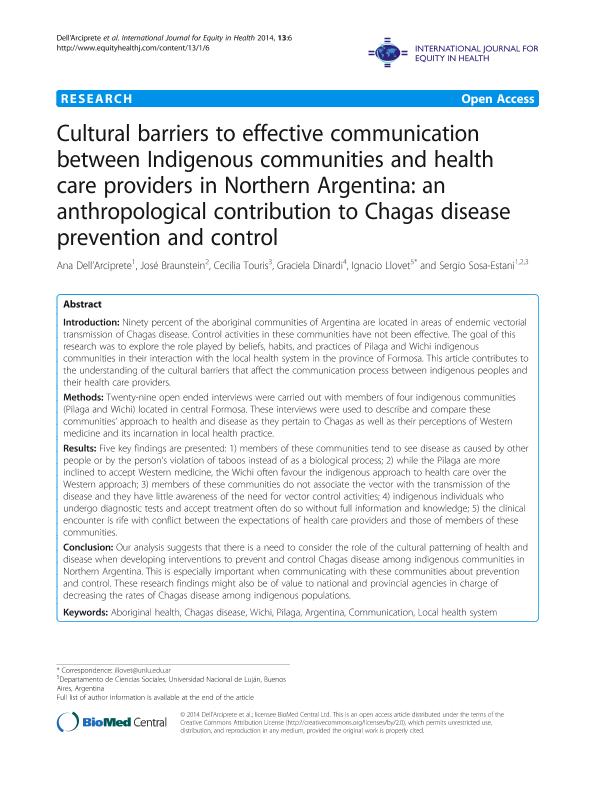Mostrar el registro sencillo del ítem
dc.contributor.author
Dell Arciprete, Paula

dc.contributor.author
Braunstein, Jose Alberto

dc.contributor.author
Touris, María Cecilia

dc.contributor.author
Dinardi, Matias Andres

dc.contributor.author
Llovet, Ignacio Diego

dc.contributor.author
Sosa-Estani, Sergio Alejandro

dc.date.available
2018-01-22T19:22:07Z
dc.date.issued
2014-01
dc.identifier.citation
Dell Arciprete, Paula; Braunstein, Jose Alberto; Touris, María Cecilia; Dinardi, Matias Andres; Llovet, Ignacio Diego; et al.; Cultural barriers to effective communication between Indigenous communities and health care providers in Northern Argentina: an anthropological contribution to Chagas disease prevention and control; BioMed Central; International Journal for Equity in Health; 13; 1-2014; 6-16
dc.identifier.issn
1475-9276
dc.identifier.uri
http://hdl.handle.net/11336/34153
dc.description.abstract
INTRODUCTION: Ninety percent of the aboriginal communities of Argentina are located in areas of endemic vectorial transmission of Chagas disease. Control activities in these communities have not been effective. The goal of this research was to explore the role played by beliefs, habits, and practices of Pilaga and Wichi indigenous communities in their interaction with the local health system in the province of Formosa. This article contributes to the understanding of the cultural barriers that affect the communication process between indigenous peoples and their health care providers.
METHODS: Twenty-nine open ended interviews were carried out with members of four indigenous communities (Pilaga and Wichi) located in central Formosa. These interviews were used to describe and compare these communities' approach to health and disease as they pertain to Chagas as well as their perceptions of Western medicine and its incarnation in local health practice.
RESULTS: Five key findings are presented: 1) members of these communities tend to see disease as caused by other people or by the person's violation of taboos instead of as a biological process; 2) while the Pilaga are more inclined to accept Western medicine, the Wichi often favour the indigenous approach to health care over the Western approach; 3) members of these communities do not associate the vector with the transmission of the disease and they have little awareness of the need for vector control activities; 4) indigenous individuals who undergo diagnostic tests and accept treatment often do so without full information and knowledge; 5) the clinical encounter is rife with conflict between the expectations of health care providers and those of members of these communities.
CONCLUSION: Our analysis suggests that there is a need to consider the role of the cultural patterning of health and disease when developing interventions to prevent and control Chagas disease among indigenous communities in Northern Argentina. This is especially important when communicating with these communities about prevention and control. These research findings might also be of value to national and provincial agencies in charge of decreasing the rates of Chagas disease among indigenous populations.
dc.format
application/pdf
dc.language.iso
eng
dc.publisher
BioMed Central

dc.rights
info:eu-repo/semantics/openAccess
dc.rights.uri
https://creativecommons.org/licenses/by/2.5/ar/
dc.subject
Aboriginal Health
dc.subject
Chagas Disease
dc.subject
Wichi
dc.subject
Pilaga
dc.subject
Argentina
dc.subject.classification
Medicina Tropical

dc.subject.classification
Ciencias de la Salud

dc.subject.classification
CIENCIAS MÉDICAS Y DE LA SALUD

dc.subject.classification
Ciencias Sociales Interdisciplinarias

dc.subject.classification
Otras Ciencias Sociales

dc.subject.classification
CIENCIAS SOCIALES

dc.title
Cultural barriers to effective communication between Indigenous communities and health care providers in Northern Argentina: an anthropological contribution to Chagas disease prevention and control
dc.type
info:eu-repo/semantics/article
dc.type
info:ar-repo/semantics/artículo
dc.type
info:eu-repo/semantics/publishedVersion
dc.date.updated
2018-01-22T14:47:07Z
dc.journal.volume
13
dc.journal.pagination
6-16
dc.journal.pais
Estados Unidos

dc.journal.ciudad
Nueva York
dc.description.fil
Fil: Dell Arciprete, Paula. Instituto de Efectividad Clínica y Sanitaria; Argentina
dc.description.fil
Fil: Braunstein, Jose Alberto. Consejo Nacional de Investigaciones Científicas y Técnicas; Argentina
dc.description.fil
Fil: Touris, María Cecilia. Dirección Nacional de Instituto de Investigación. Administración Nacional de Laboratorio e Instituto de Salud “Dr. C.G. Malbrán”. Instituto Nacional de Parasitología “Dr. M. Fatala Chabén”; Argentina
dc.description.fil
Fil: Dinardi, Matias Andres. Universidad Nacional de Tres de Febrero; Argentina
dc.description.fil
Fil: Llovet, Ignacio Diego. Universidad Nacional de Luján. Departamento de Ciencias Sociales; Argentina
dc.description.fil
Fil: Sosa-Estani, Sergio Alejandro. Instituto de Efectividad Clínica y Sanitaria; Argentina. Consejo Nacional de Investigaciones Científicas y Técnicas; Argentina. Dirección Nacional de Instituto de Investigación. Administración Nacional de Laboratorio e Instituto de Salud “Dr. C.G. Malbrán”. Instituto Nacional de Parasitología “Dr. M. Fatala Chabén”; Argentina
dc.journal.title
International Journal for Equity in Health
dc.relation.alternativeid
info:eu-repo/semantics/altIdentifier/url/https://equityhealthj.biomedcentral.com/articles/10.1186/1475-9276-13-6
dc.relation.alternativeid
info:eu-repo/semantics/altIdentifier/doi/http://dx.doi.org/10.1186/1475-9276-13-6
dc.relation.alternativeid
info:eu-repo/semantics/altIdentifier/url/https://www.ncbi.nlm.nih.gov/pmc/articles/PMC3909457/
Archivos asociados
